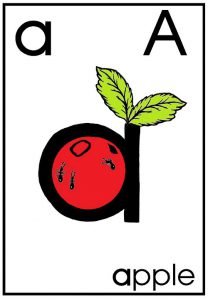
Learning the basic sound represented by each letter of the alphabet is a critical component of developing literacy. In reading, students must learn to differentiate letters from one another, many of which are very similar in appearance (e.g., m/n/h) and in some cases identical when rotated (e.g., b/d/p/q). In writing, students must learn the sound represented by a particular letter, many of which are very similar (e.g., the only difference between /d/ and /t/ is that one if voiced and other is voiceless). This is further complicated because many letters can be read in more than one way (‘a’ can be read as /a/ as in apple, /e/ as in many, /o/ as in was, etc.) and many sounds can be represented with more than one letter or letter combination (e.g., /ay/ can be ‘ai’ as in rain, ‘a’ as in table, ‘ay’ as in tray, ‘a-e’ as in cake, etc.). In addition, the very formation of letters may added a further difficulty for students who have poor fine motor control.
Effective Strategies
- Teach lower case letters first as these are more frequently encountered.
- Teach the sounds of letters before the names of letters.
- Link the letter to a picture cue that begins with the common basic sound of that letter and has some visual similarity to the shape of the letter (e.g., if the letter ‘a’ is coloured in red and some leaves added it looks like an apple which also begins with the /a/ sound).
- Use a multisensory approach that includes movement, action cues and tactile input from tracing the letter with a finger.
- Help students make their own Alphabet Book that includes pictures beginning with the sound of the letter being taught.
- Explicitly teach the correct formation of the letter, including the starting position, the correct direction of movement, correct positioning and correct sizing.
- Teach letters in groups in which the letters do not look or sound like each other to minimise confusion and which when combined can be used to form words that the student can decode (read) and encode (spell) given their current knowledge of the sounds of the alphabet.
- Provide a range of phonological awareness activities which require the student to identify and manipulate the sounds being taught. This should include the child identifying the location of the sound at the beginning, in the middle and at the end of a word.
- Provide multiple opportunities to practise the sounds in isolation and within words (e.g. once the child knows c, t, a, r, u, n they can learn to read and spell words like cat, run, rat, tan, can, etc.).
- Include games that reinforce knowledge of the letter sounds (e.g., Alphabet Bingo, Alphabet Card Games, Alphabet Dominoes, etc.).
- Combine the words being learned into simple sentences which students then learn to read.
- Expose students to variant forms of the letter and point out these different fonts in the child’s daily environment.
- Once letters have been taught continue to expose students to these letters as other letters are introduced. In fact, promote over learning to ensure completely automatic responses both in terms of reading and writing the letter
- Monitor students’ acquisition of the sounds of the alphabet. Re-teach and provide more practise for those letters that have not been retained. Think of strategies to assist in this process. For example ‘d’ is like ‘a’ but with a longer ‘stick’ or one parent came up with the idea of having his child make a ‘b’ by using their arm to make a straight line in the sand and then using the fist to make the bulb and this was repeated multiple times in the sand at the beach while saying /b/ for bat and ball.
For more information about teaching the alphabet
References
Cook, S., Yip, T., & Goldin-Meadow, S., (2010). Gesturing makes memories that last, Journal of Memory and Language, 63 (4), 465-475
Shmidman, A., & Ehri, L. (2010). Embedded picture mnemonics to learn letters Scientific Studies of Reading, 14 (2), 159
Treiman, R. Stothard, S. E., & Snowling, M. J. (2013). Instruction matters: Spelling of vowels by children in England and the US. Reading and Writing: An Interdisciplinary Jo The US and England have taken different positions on
